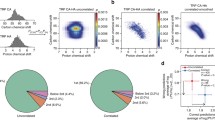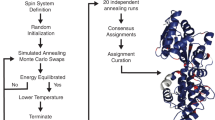Abstract
Sequential resonance assignment represents an essential step towards the investigation of protein structure, dynamics, and interaction surfaces. Although the experimental sensitivity has significantly increased in recent years, with the availability of high field magnets and cryogenically cooled probes, resonance assignment, even of small globular proteins, still generally requires several days of data collection and analysis using standard protocols. Here we introduce the BATCH strategy for fast and highly automated backbone resonance assignment of 13C, 15N-labelled proteins. BATCH makes use of the fast data acquisition and analysis tools BEST, ASCOM, COBRA, and HADAMAC, recently developed in our laboratory. An improved Hadamard encoding scheme, presented here, further increases the performance of the HADAMAC experiment. A new software platform, interfaced to the NMRView software package, has been developed that enables highly automated NMR data processing and analysis, sequential resonance assignment, and 13C chemical shift extraction. We demonstrate for four small globular proteins that sequential resonance assignment can be routinely obtained within a few hours, or less, in a highly automated and robust way.






Similar content being viewed by others
References
Atreya HS, Szyperski T (2004) G-matrix Fourier transform NMR spectroscopy for complete protein resonance assignment. Proc Natl Acad Sci U S A 101:9642–9647
Bartels C, Güntert P, Billeter M, Wüthrich K (1997) GARANT—a general algorithm for resonance assignment of multidimensional nuclear magnetic resonance spectra. J Comput Chem 18:139–149
Blevins RA, Johnson BA (1994) NMRView: a computer program for the visualization and analysis of NMR data. J Biomol NMR 4:603–614
Bruschweiler R (2004) Theory of covariance nuclear magnetic resonance spectroscopy. J Chem Phys 121:409–414
Brutscher B (2004) Combined frequency- and time-domain NMR spectroscopy. Application to fast protein resonance assignment. J Biomol NMR 29:57–64
Brutscher B, Simorre JP, Caffrey MS, Marion D (1994) Design of a complete set of two-dimensional triple-resonance experiments for assigning labeled proteins. J Magn Reson B 105:77–82
Coggins BE, Zhou P (2003) PACES: protein sequential assignment by computer-assisted exhaustive search. J Biomol NMR 26:93–111
Cornilescu G, Bahrami A, Tonelli M, Markley JL, Eghbalnia HR (2007) HIFI-C: a robust and fast method for determining NMR couplings from adaptive 3D to 2D projections. J Biomol NMR 38:341–351
Delaglio F, Grzesiek S, Vuister GW, Zhu G, Pfeifer J, Bax A (1995) NMRPipe: a multidimensional spectral processing system based on UNIX pipes. J Biomol NMR 6:277–293
Deschamps M, Campbell ID (2006) Cooling overall spin temperature: protein NMR experiments optimized for longitudinal relaxation effects. J Magn Reson 178:206–211
Friedrichs MS, Mueller L, Wittekind M (1994) An automated procedure for the assignment of protein 1HN, 15N, 13C alpha, 1H alpha, 13C beta and 1H beta resonances. J Biomol NMR 4:703–726
Frydman L, Scherf T, Lupulescu A (2002) The acquisition of multidimensional NMR spectra within a single scan. Proc Natl Acad Sci U S A 99:15858–15862
Frydman L, Lupulescu A, Scherf T (2003) Principles and features of single-scan two-dimensional NMR spectroscopy. J Am Chem Soc 125:9204–9217
Gal M, Schanda P, Brutscher B, Frydman L (2007) UltraSOFAST HMQC NMR and the repetitive acquisition of 2D protein spectra at Hz rates. J Am Chem Soc 129:1372–1377
Hiller S, Fiorito F, Wuthrich K, Wider G (2005) Automated projection spectroscopy (APSY). Proc Natl Acad Sci U S A 102:10876–10881
Jaravine VA, Orekhov VY (2006) Targeted acquisition for real-time NMR spectroscopy. J Am Chem Soc 128:13421–13426
Jaravine V, Ibraghimov I, Orekhov VY (2006) Removal of a time barrier for high-resolution multidimensional NMR spectroscopy. Nat Methods 3:605–607
Jaravine VA, Zhuravleva AV, Permi P, Ibraghimov I, Orekhov VY (2008) Hyperdimensional NMR spectroscopy with nonlinear sampling. J Am Chem Soc 130:3927–3936
Jung YS, Zweckstetter M (2004) Mars—robust automatic backbone assignment of proteins. J Biomol NMR 30:11–23
Kazimierczuk K, Kozminski W, Zhukov I (2006) Two-dimensional Fourier transform of arbitrarily sampled NMR data sets. J Magn Reson 179:323–328
Kim S, Szyperski T (2003) GFT NMR, a new approach to rapidly obtain precise high-dimensional NMR spectral information. J Am Chem Soc 125:1385–1393
Kupce E, Freeman R (2003a) Frequency-domain Hadamard spectroscopy. J Magn Reson 162:158–165
Kupce E, Freeman R (2003b) Projection-reconstruction of three-dimensional NMR spectra. J Am Chem Soc 125:13958–13959
Lescop E, Brutscher B (2007) Hyperdimensional protein NMR spectroscopy in peptide-sequence space. J Am Chem Soc 129:11916–11917
Lescop E, Schanda P, Brutscher B (2007a) A set of BEST triple-resonance experiments for time-optimized protein resonance assignment. J Magn Reson 187:163–169
Lescop E, Schanda P, Rasia R, Brutscher B (2007b) Automated spectral compression for fast multidimensional NMR and increased time resolution in real-time NMR spectroscopy. J Am Chem Soc 129:2756–2757
Lescop E, Rasia R, Brutscher B (2008) Hadamard amino-acid-type edited NMR experiment for fast protein resonance assignment. J Am Chem Soc 130:5014–5015
Leutner M, Gschwind RM, Liermann J, Schwarz C, Gemmecker G, Kessler H (1998) Automated backbone assignment of labeled proteins using the threshold accepting algorithm. J Biomol NMR 11:31–43
Lin G, Xu D, Chen ZZ, Jiang T, Wen J, Xu Y (2002) An efficient branch-and-bound algorithm for the assignment of protein backbone NMR peaks. Proc IEEE Comput Soc Bioinform Conf 1:165–174
Lin HN, Wu KP, Chang JM, Sung TY, Hsu WL (2005) GANA—a genetic algorithm for NMR backbone resonance assignment. Nucleic Acids Res 33:4593–4601
Lin G, Wan X, Tegos T, Li Y (2006) Statistical evaluation of NMR backbone resonance assignment. Int J Bioinform Res Appl 2:147–160
Lukin JA, Gove AP, Talukdar SN, Ho C (1997) Automated probabilistic method for assigning backbone resonances of (13C, 15N)-labeled proteins. J Biomol NMR 9:151–166
Marion D (2005) Fast acquisition of NMR spectra using Fourier transform of non-equispaced data. J Biomol NMR 32:141–150
Masse JE, Keller R (2005) AutoLink: automated sequential resonance assignment of biopolymers from NMR data by relative-hypothesis-prioritization-based simulated logic. J Magn Reson 174:133–151
Monleon D, Colson K, Moseley HN, Anklin C, Oswald R, Szyperski T, Montelione GT (2002) Rapid analysis of protein backbone resonance assignments using cryogenic probes, a distributed Linux-based computing architecture, and an integrated set of spectral analysis tools. J Struct Funct Genomics 2:93–101
Olson JB Jr, Markley JL (1994) Evaluation of an algorithm for the automated sequential assignment of protein backbone resonances: a demonstration of the connectivity tracing assignment tools (CONTRAST) software package. J Biomol NMR 4:385–410
Orekhov VY, Ibraghimov IV, Billeter M (2001) MUNIN: a new approach to multi-dimensional NMR spectra interpretation. J Biomol NMR 20:49–60
Orekhov VY, Ibraghimov I, Billeter M (2003) Optimizing resolution in multidimensional NMR by three-way decomposition. J Biomol NMR 27:165–173
Pantoja-Uceda D, Santoro J (2008) Amino acid type identification in NMR spectra of proteins via beta- and gamma-carbon edited experiments. J Magn Reson 195:187–195
Pervushin K, Vogeli B, Eletsky A (2002) Longitudinal (1)H relaxation optimization in TROSY NMR spectroscopy. J Am Chem Soc 124:12898–12902
Ribeiro EA Jr, Favier A, Gerard FC, Leyrat C, Brutscher B, Blondel D, Ruigrok RW, Blackledge M, Jamin M (2008) Solution structure of the C-terminal nucleoprotein-RNA binding domain of the vesicular stomatitis virus phosphoprotein. J Mol Biol 382:525–538
Rovnyak D, Frueh DP, Sastry M, Sun ZY, Stern AS, Hoch JC, Wagner G (2004) Accelerated acquisition of high resolution triple-resonance spectra using non-uniform sampling and maximum entropy reconstruction. J Magn Reson 170:15–21
Schanda P, Van Melckebeke H, Brutscher B (2006) Speeding up three-dimensional protein NMR experiments to a few minutes. J Am Chem Soc 128:9042–9043
Slupsky CM, Boyko RF, Booth VK, Sykes BD (2003) Smartnotebook: a semi-automated approach to protein sequential NMR resonance assignments. J Biomol NMR 27:313–321
Vitek O, Vitek J, Craig B, Bailey-Kellogg C (2004) Model-based assignment and inference of protein backbone nuclear magnetic resonances. Stat Appl Genet Mol Biol 3:6
Vitek O, Bailey-Kellogg C, Craig B, Kuliniewicz P, Vitek J (2005) Reconsidering complete search algorithms for protein backbone NMR assignment. Bioinformatics 21(Suppl 2):230–236
Vitek O, Bailey-Kellogg C, Craig B, Vitek J (2006) Inferential backbone assignment for sparse data. J Biomol NMR 35:187–208
Volk J, Herrmann T, Wuthrich K (2008) Automated sequence-specific protein NMR assignment using the memetic algorithm MATCH. J Biomol NMR 41:127–138
Wan X, Lin G (2006) A graph-based automated NMR backbone resonance sequential assignment. Comput Syst Bioinformatics Conf 5:5–66
Wan X, Lin G (2007) GASA: a graph-based automated NMR backbone resonance sequential assignment program. J Bioinform Comput Biol 5:313–333
Wu KP, Chang JM, Chen JB, Chang CF, Wu WJ, Huang TH, Sung TY, Hsu WL (2006) RIBRA—an error-tolerant algorithm for the NMR backbone assignment problem. J Comput Biol 13:229–244
Zimmerman DE, Kulikowski CA, Huang Y, Feng W, Tashiro M, Shimotakahara S, Chien C, Powers R, Montelione GT (1997) Automated analysis of protein NMR assignments using methods from artificial intelligence. J Mol Biol 269:592–610
Acknowledgments
This work was supported by the Commissariat à l’Energie Atomique, the Centre National de la Recherche Scientifique, the University Grenoble 1, the French Research Agency (ANR-JCJC-05-0077), and the European commission (I3, EU-NMR, Contract No. 026145). We thank I. Ayala for preparation of the ubiquitin sample, P. Gans for the calmodulin sample, and B. Bersch, K.-M. Derfoufi, G. Vandenbussche, R. Rasia, J. Boisbouvier, and M. Jamin, for making samples of HMR, Hyl1 and VSV-PCTD available for this study.
Author information
Authors and Affiliations
Corresponding authors
Electronic supplementary material
Below is the link to the electronic supplementary material.
Rights and permissions
About this article
Cite this article
Lescop, E., Brutscher, B. Highly automated protein backbone resonance assignment within a few hours: the «BATCH» strategy and software package. J Biomol NMR 44, 43–57 (2009). https://doi.org/10.1007/s10858-009-9314-2
Received:
Revised:
Accepted:
Published:
Issue Date:
DOI: https://doi.org/10.1007/s10858-009-9314-2




